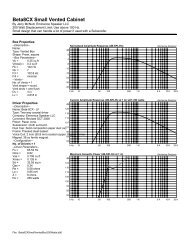MB15 & MB30 - Marshall
MB15 & MB30 - Marshall
MB15 & MB30 - Marshall
You also want an ePaper? Increase the reach of your titles
YUMPU automatically turns print PDFs into web optimized ePapers that Google loves.
ENGLISH<br />
From Jim <strong>Marshall</strong><br />
I would like to thank you personally for selecting<br />
one of our new MB Bass amplifiers.<br />
As a musician myself I fully understand the necessity<br />
of achieving the right tone and feel to help inspire<br />
musicians to reach their full creative potential – be<br />
they aspiring beginners or more skilled players. With<br />
this in mind I set my experienced R&D team the task of<br />
designing a new range of affordable bass amplifiers that<br />
truly captured the essence of the <strong>Marshall</strong> sound.<br />
Utilising new technologies, some of which were developed for<br />
our critically acclaimed AVT range, the new MB Series raises<br />
the standard for what can be expected from a value-for-money<br />
range of bass amplifiers and defines a new benchmark.<br />
Like all the amplifiers in my new MB range, this amp was completely designed and<br />
engineered in the UK and the most rigorous quality control procedures ensure that it meets<br />
the standard of build you have come to expect from all <strong>Marshall</strong> products.<br />
Whether this is your first ever <strong>Marshall</strong> or is the latest addition to your arsenal of amps, the<br />
tone, flexibility and feel of this compact, rugged combo will deliver the goods – from<br />
bedroom to backstage!<br />
I wish you every success with your new <strong>Marshall</strong>. Welcome to the family…<br />
Yours Sincerely,<br />
Dr Jim <strong>Marshall</strong> OBE and daughter Victoria (Managing Director)<br />
1
ENGLISH<br />
<strong>MB15</strong> Front Panel Features<br />
1 2 3 4 5 6 7 8 10 11 12 13 14 15<br />
<strong>MB30</strong> Front Panel Features<br />
12. CD IN<br />
If you want to jam to your favourite CD, tape or mp3<br />
player, merely connect the headphone output of your<br />
device here, adjust the player’s volume to match that<br />
of your guitar and ‘hey-presto’ – you’ve got the<br />
perfect ‘play-along’ practice system.<br />
13. LINE OUT Jack Socket - <strong>MB15</strong><br />
(Rear panel of the <strong>MB30</strong> - see below)<br />
You can use this socket to connect the amp to your<br />
multi-track recording machine and you’ll get a great<br />
speaker emulated guitar sound direct to disk or<br />
tape.<br />
14. HEADPHONES Jack Socket<br />
For use when silent practice is the order of the day.<br />
Connection of headphones will automatically shut<br />
down the internal speaker.<br />
15. POWER Switch<br />
The power switch turns your amplifier on and off.<br />
The LED next to the ‘Modern / Classic switch will<br />
light up when your amplifier is turned on and will<br />
not be lit when the amplifier is switched off.<br />
Note: The specific mains input voltage rating that<br />
your amplifier has been built for is shown on the<br />
back panel. Before connecting to the mains<br />
electricity supply, always ensure that your amplifier<br />
is compatible with your electricity supply. If you<br />
have any doubt, please get advice from a qualified<br />
technician. Your <strong>Marshall</strong> dealer will help you in this<br />
respect.<br />
Please ensure the amplifier is switched off and<br />
unplugged from the mains electricity supply before<br />
being moved.<br />
ENGLISH<br />
1 2 3 4 5 6 7 8 9 10 11 12 14 15<br />
Note: The power amplifier is protected by a<br />
clipping limiter, so even when you play your amp<br />
loud, the sound remains clean.<br />
1. INPUT Jack Socket<br />
Jack input for your bass guitar. Use a good quality<br />
guitar cable (i.e. one that’s screened/shielded) to help<br />
prevent noise, interference and unwanted feedback.<br />
2. VOLUME Control - Modern Channel<br />
This control adjusts the volume of the Modern<br />
Channel.<br />
3. COMPRESSOR Switch & LED<br />
This switch turns the Compressor control on and off.<br />
When the switch is ‘in’ the Compressor control is<br />
active and the LED will be illuminated green.<br />
4. COMPRESSOR Control<br />
The Compressor smoothes out your bass sound.<br />
As you increase the amount of compression, so you<br />
flatten out the peaks in the incoming signal. When<br />
the compression reaches its threshold the LED will<br />
change to red.<br />
5. MODERN / CLASSIC Switch<br />
This push switch allows you to change between the<br />
amp’s two channels, Modern and Classic, via the<br />
front panel. When this switch is ‘out’ the Modern<br />
Channel is engaged and the LED will be green.<br />
Pushing it ‘in’ switches to the Classic Channel and<br />
the LED changes to red.<br />
6. GAIN Control<br />
This control sets the operating level of pre-amp. If<br />
you require a clean bass sound turn this control up<br />
until your bass just starts to distort and then back it<br />
off slightly. If, on the other hand you would like a<br />
distorted sound, simply turn up the Gain control until<br />
the required amount of distortion is achieved.<br />
7. VOLUME Control - Classic Channel<br />
This control adjusts the volume of the Classic<br />
Channel.<br />
2<br />
8. BASS Control<br />
Turning the Bass control will effect the amount of<br />
low frequencies or bottom end in your bass guitar<br />
tone. Rotating this clockwise will increase the<br />
amount of lower tones generally making your bass<br />
sound deeper. Turning this control anti-clockwise<br />
will reduce the bass frequencies in your tone<br />
producing a reduction in bottom end thud.<br />
9. VOICE SHIFT Control (<strong>MB30</strong> only)<br />
This 3 position control adjusts the overall tonal<br />
voicing of the amplifier.<br />
Position 1 tailors the response of the amplifier for<br />
smooth low end, restrained lower mids, and mild<br />
high end lift, to give the classic vintage valve bass<br />
tone.<br />
In position 2 the lower mid is made more prominent<br />
whilst simultaneously the upper mids are subtly<br />
scooped to give a more aggressive, growling quality<br />
to the amplifier's tone.<br />
Position 3 introduces a gentle overall mid boost for<br />
an immediate, cutting, 'in your face' tone with the<br />
mids scooped even further to give an immediate,<br />
cutting sound… it is not a mid boost.<br />
10. VOICE Control<br />
This control adjusts the response selected by the<br />
Voice Shift control. On the <strong>MB15</strong> the Voice Shift<br />
control is similar to position 2 on the <strong>MB30</strong>.<br />
11. TREBLE Control<br />
By adjusting the Treble control you can add or take<br />
away the higher frequencies in your bass guitar tone.<br />
By increasing the amount of treble you will make your<br />
tone brighter, ideal for more percussive playing styles.<br />
<strong>MB30</strong> Rear Panel Features<br />
1. FOOTSWITCH Jack Socket<br />
Connect the optional footswitch (PEDL-10008) here<br />
enables you to change between Modern and<br />
Classic channels.<br />
2. SEND Jack Socket<br />
If you want to use an external effects processor in<br />
your amp’s built-in Series FX effects loop, this is<br />
the jack you connect to the INPUT of the unit you<br />
are using.<br />
3. RETURN Jack Socket<br />
This is where you connect the OUTPUT of the<br />
effects processor you are using in the effects loop.<br />
1 2 3 4<br />
3<br />
4. LINE OUT Jack Socket<br />
You can use this socket to connect the <strong>MB30</strong> to<br />
your multi-track recording machine and you’ll get a<br />
great speaker emulated guitar sound direct to disk<br />
or tape.<br />
HELPFUL HINT: for ‘silent’ recording merely plug<br />
an unconnected jack plug into the headphone<br />
socket and you’ll disconnect the <strong>MB30</strong>’s internal<br />
speaker.<br />
EUROPE ONLY - Note: This equipment has been tested and found to comply with the requirements<br />
of the EMC Directive (Environments E1, E2 and E3 EN 55103-1/2) and the Low Voltage Directive in the E.U.<br />
EUROPE ONLY - Note: The Peak Inrush current for the <strong>MB15</strong> is 2.5 amps.<br />
The Peak Inrush current for the <strong>MB30</strong> is 5 amps.<br />
Follow all instructions and heed all warnings<br />
KEEP THESE INSTRUCTIONS !
<strong>MB15</strong> Suggested Settings<br />
Here follows some sample settings to act as starting points from which to develop your own sounds.<br />
N.B. Volume should be adjusted to taste.<br />
Slap - funky<br />
<strong>MB30</strong> Suggested Settings<br />
Here follows some sample settings to act as starting points from which to develop your own sounds.<br />
N.B. Volume should be adjusted to taste.<br />
Slap - funky<br />
ENGLISH<br />
IN<br />
OUT<br />
IN<br />
OUT<br />
ENGLISH<br />
Jazz<br />
Jazz<br />
OUT<br />
OUT<br />
OUT<br />
OUT<br />
Hard Rock<br />
Hard Rock<br />
OUT<br />
IN<br />
OUT<br />
IN<br />
Modern Rock - detuned bass<br />
Modern Rock - detuned bass<br />
OUT<br />
IN<br />
OUT<br />
IN<br />
<strong>MB15</strong> Technical Specification<br />
<strong>MB30</strong> Technical Specification<br />
Power Output<br />
Main Bass Guitar • Input Impedance<br />
CD Input • Input Impedance<br />
Emulated Output • Level<br />
Weight (approx)<br />
Size (mm) Width, Height, Depth (approx)<br />
15W RMS into 4Ω<br />
1MΩ<br />
22kΩ<br />
-10dBV<br />
10.8kg<br />
390mm x 380mm x 240mm<br />
Power Output<br />
Main Bass Guitar • Input Impedance<br />
CD Input • Input Impedance<br />
Emulated Output • Level<br />
Weight (approx)<br />
Size (mm) Width, Height, Depth (approx)<br />
30W RMS into 4Ω<br />
1MΩ<br />
22kΩ<br />
-10dBV<br />
13.6kg<br />
440mm x 410mm x 260mm<br />
4<br />
5



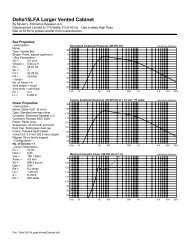
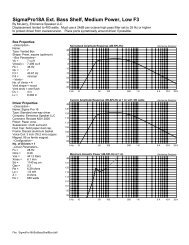
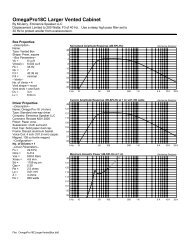

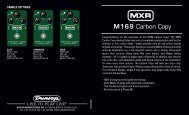


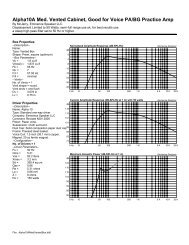
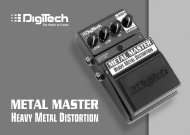
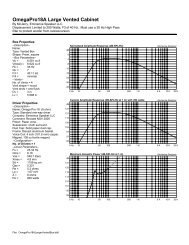
![MG15CFX-MG100HCFX [1.04 MB] - Marshall](https://img.yumpu.com/41208060/1/184x260/mg15cfx-mg100hcfx-104-mb-marshall.jpg?quality=85)


